Rx 480 Make Fans Continuously Blow
Since last year, AMD's (NASDAQ:AMD) stock price has more than doubled as investors are buying into the hype that the long-awaited turnaround is just around the corner. The company announced new business deals, hyped up its Polaris lineup and expectations are high for a return to competitiveness in the CPU market. While we still know precious little about Zen, yesterday's launch of the Radeon RX 480 offers the opportunity to take an in-depth look at whether the hype is coming to fruition.
The last four weeks, the Radeon RX 480 has been the talk of the town on all tech websites as AMD stunned enthusiasts by announcing that it would bring virtual reality and Full HD gaming to the masses with a card that costs just $199. AMD is no charity of course so the low pricing of the card gave me an uneasy feeling as it reveals a lack of pricing power.
Last decade when AMD was at the top of its game in the CPU market, it wasn't uncommon to see AMD CPUs selling for more than the Intel counterpart because AMD's silicon offered significant enough advantages. Those days are long gone and unfortunately the reviews of the RX 480 confirm there are some rather significant caveats.
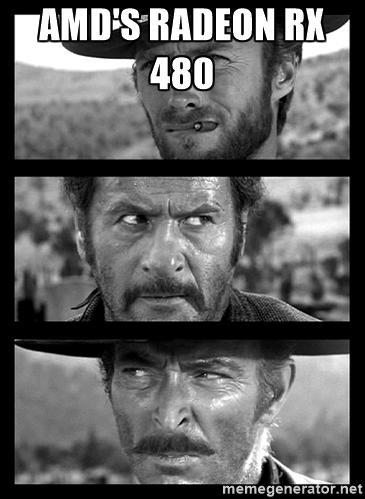
RX 480 performance per dollar is top notch
Lets start with the good news. From a performance per dollar perspective, the Radeon RX 480 is one of the best cards on the market. For $239 (or $199 when the 4GB cards are available in volume) you're buying a card capable of delivering very good Full HD gaming performance.
As illustrated by this chart from TechPowerUp's review, there's nothing quite like the Radeon RX 480. A quick scan of several reviews reveals consensus puts the performance of the Radeon RX 480 slightly above the performance of the Radeon R9 390 and GeForce GTX 970. The RX 480 is a couple of percentage points faster in most games, but in some tests it's a bit slower. And of course, a higher proportion of DirectX 12 games tips the balance in favor of the RX 480.
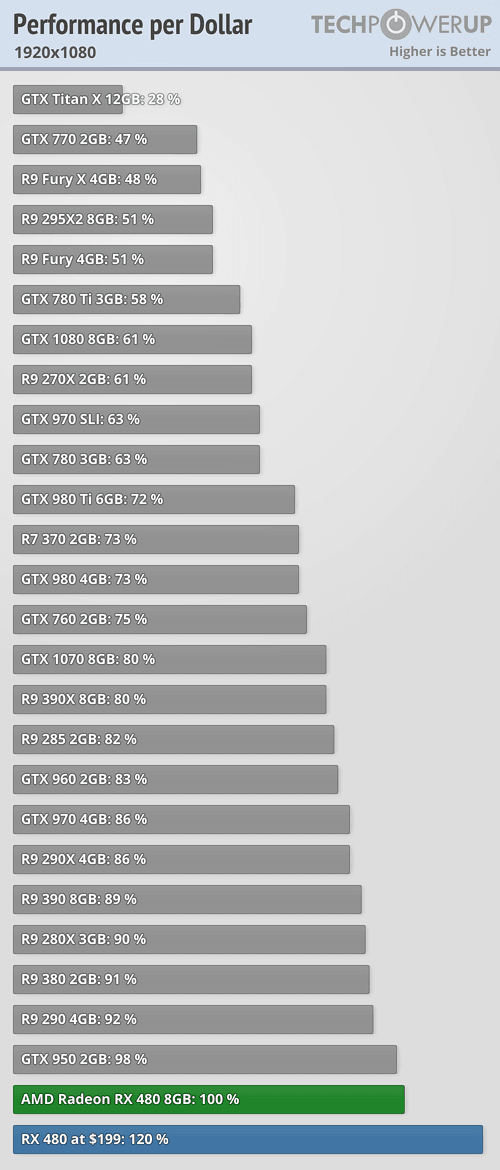
To me this identifies the first weakness of this card. It's the fastest new card in AMD's lineup until Vega arrives ~6 months from now, but it's barely faster than last generation. The low pricing of the RX480 has nothing to do with altruism, it's all about turning lemons into lemonade.
And as I'll illustrate further below, gamers should wait for the custom versions from the add-in board partners because the reference card has several issues. If the custom cards are priced over $250 it's going to change the value perception of this card, and NVIDIA's GeForce GTX 1060 is rumored to follow just two weeks from now.
Performance per Watt not living up to the hype
While the last generation was made on a 28nm process, Polaris is manufactured on a 14nm FinFET process. According to AMD's own marketing material, the Radeon RX 480 delivers an up to 2.8x increase in performance/Watt versus the Radeon R9 200 series.
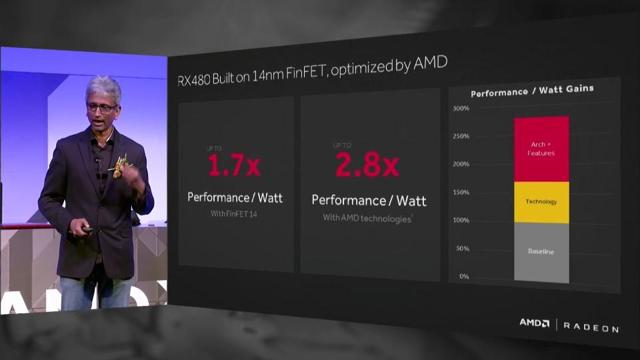
Image source: ThinkComputers
Such a massive increase in efficiency was exactly what AMD needed but unfortunately it does not register in the reviews. Heading back to the TechPowerUp review, we can see that the performance/Watt of the Radeon RX 480 is far from impressive. It's a lot better than AMD's previous generation, but barely better than the 28nm-based GeForce GTX 970.
NVIDIA's 16nm FinFET based Pascal GPUs completely obliterate the RX 480 in terms of energy efficiency. The GeForce GTX 1080 has very similar power consumption as the RX 480, but much higher performance. This really sets of alarm bells.
Without a doubt, there will be rare scenarios where Polaris is indeed 2.8x more efficient than the R9 290 "Hawaii" GPUs but the keywords really are "up to". In average gaming use, you're looking at a much smaller increase.
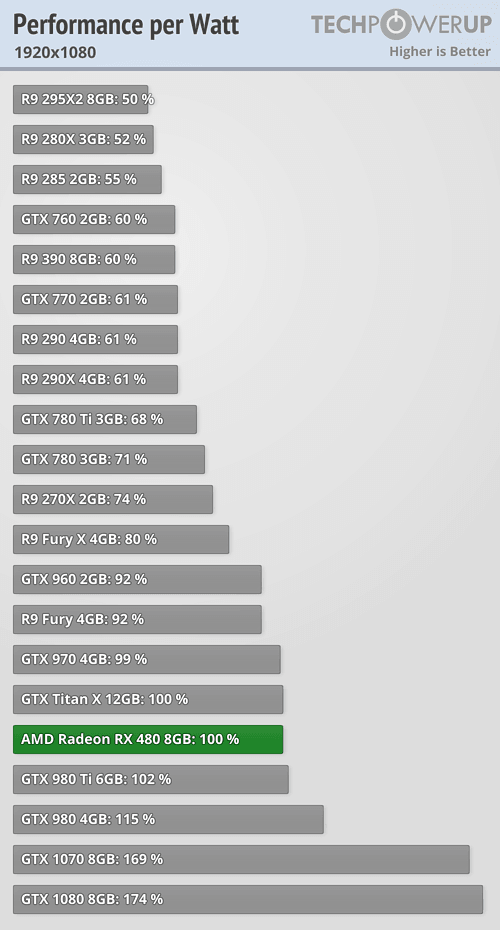
Reference card cooler is a bit too cheap
AMD equipped the reference card with a simple cooling solution, it doesn't use any heatpipes. It has a small aluminum heatsink with a copper core and just one small blower style fan. This keeps the costs down and if the card was as efficient as AMD claimed it would be, it wouldn't be a problem.
But as reported by The Tech Report, GPU temperatures reach 83°C under load despite a system noise level of 51dBA. Under the same test scenario, NVIDIA's GeForce GTX 970 hit a temperature of just 64°C with a noise level of 48dBA. The site writes the reference cooler doesn't sound pleasant, the reviewer describes it as "grindy and obtrusive."
Given the price tag, this can be forgiven but it's not something you'd expect on a card that's marketed as efficient. AMD's add-in board partners will fix this but better coolers will likely drive up the price a bit.
Reference card offers poor overclocking
Despite several rumors and the launch of AMD's new WattMan overclocking tool, the Radeon RX 480 is anything but a good overclocker. Most reviews show a maximum potential of around 1350MHz with the reference model, or about 5-7 percent. For most consumers this is probably a non-issue and I fully expect the AIB cards will offer much better overclocking.
Where it gets ugly: the power consumption
The biggest issue with the Radeon RX 480 is not only how much power it consumes, but also where it draws its power. The card has a target TDP of 150W but reviews show the card's average power consumption exceeds the TDP.
As evidenced by this chart from the Tom's Hardware review, the average gaming power consumption of the RX 480 is 164W. While the high average power consumption further illustrates that AMD's presentation about efficiency was bogus, the real issue is how the card draws its power.
As Tom's Hardware points out, the lack of an 8-pin PCIe power connector was a big mistake in the design of the Radeon RX 480 reference card. In theory, the card can draw 75W from its 6-pin PCIe power connector and a maximum of 75W from the motherboard's PCI Express x16 slot (60W from the 12V and 15W from the 3.3V). Exceeding the maximum rating of the PCIe power connectors isn't seen as a big deal, but unfortunately the load distribution works out in a way that the card draws excessive power from the motherboard's PCIe slot.
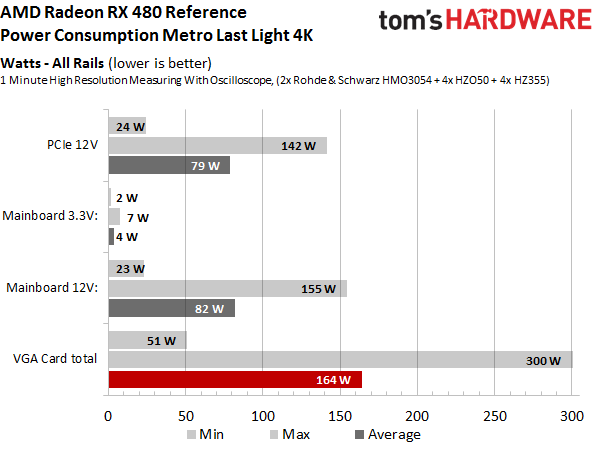
The second chart from Tom's Hardware reveals the power draw from the motherboard slot is consistently above the maximum allowed by the PCI Express specification. Average power draw from the PCIe slot is 86W and there are brief spikes to 155W. For comparison, the GeForce GTX 980 Ti has an average motherboard slot power consumption of 54.65W, with spikes of just 72.67W.
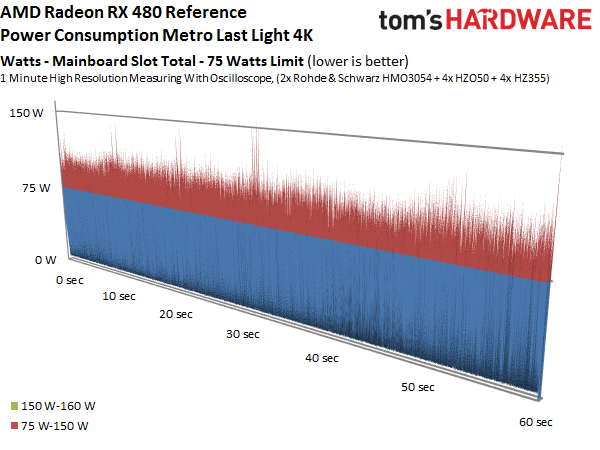
The PCIe slot power draw is off the charts, in the short term this may not be a problem but it could be a risk to the lifetime of your computer. Especially budget motherboards may be less forgiving to this kind of abuse than high-end motherboards, and it's the former that will be used by a lot of RX 480 buyers. The reviewer concludes that while there's no immediate danger, the high power draw may cause some annoyances:
With peaks of up to 155W, we have to be thankful they're brief, and not putting the motherboard in any immediate danger. However, the audio subsystems on cheaper platforms will have a hard time dealing with them. This means that the "you can hear what you see" effect will be in full force during load changes; activities like scrolling may very well result in audible artifacts. - Tom's Hardware
While tech sites typically torture hardware to get the best results, Tom's Hardware mentions they skipped long-term overclocking and overvolting tests because PCIe slot power consumption jumped to 100W, with peaks of 200W:
We skipped long-term overclocking and overvolting tests, since the Radeon RX 480's power consumption through the PCIe slot jumped to an average of 100W, peaking at 200W. We just didn't want to do that to our test platform.
In a response on Reddit, AMD's Technical Marketing head Robert Hallock claims the Radeon RX 480 meets the bar for PCI Express compliance testing with PCI-SIG. He claims AMD will be investigating the issue and downplays it, claiming it was encountered by "only a very small number of hundreds of RX 480 reviews worldwide."
We will have more on this topic soon as we investigate, but it's worth reminding people that only a very small number of hundreds of RX 480 reviews worldwide encountered this issue. Clearly that makes it aberrant, rather than the rule, and we're working to get that number down to zero.
While his damage control is technically correct, it is quite normal that just a fraction of tech reviewers discovered the issue because just a small minority of YouTube reviewers, gaming websites and tech sites have access to the expensive equipment required to test this in great detail.
Throw in a budget motherboard, a cheap power supply and an enthusiastic teen who wants to push his card to the limits and you're asking for trouble with a card like the RX 480 that is already out-of-spec at its factory clockspeeds. Whether done by design or an oversight of a bug, both reflect badly on AMD. And unless it's a weird bug that causes power draw to spike for no apparent reason, a fix for the high PCIe slot power consumption will likely reduce the maximum performance of the card.
NVIDIA (NVDA) suffered a marketing disaster when just 3.5GB out of the GeForce GTX 970's 4GB GDDR5 memory turned out to be operable at full speed, but the "powergate" of the Radeon RX 480 could be a more severe issue. There's the potential for a shortened lifetime of your PC components and a fix could result in a performance drop.
As such, AMD fans better wait for custom cards from AIBs with a 8-pin PCIe power connector. The reference design AMD cooked up really is too cheap, and a look at the forums reveals a lot of enthusiasts are starting to think twice about buying it.
***
UPDATE: July 2, 2016
AMD officially acknowledged the power draw issue. According to the company, this occurs in "select scenarios" with "some RX 480 boards" and the good news is that the behavior can be resolved via a driver fix. More news is expected on Tuesday, July 5, 2016.
As you know, we continuously tune our GPUs in order to maximize their performance within their given power envelopes and the speed of the memory interface, which in this case is an unprecedented 8Gbps for GDDR5. Recently, we identified select scenarios where the tuning of some RX 480 boards was not optimal. Fortunately, we can adjust the GPU's tuning via software in order to resolve this issue. We are already testing a driver that implements a fix, and we will provide an update to the community on our progress on Tuesday (July 5, 2016).
***
***
UPDATE: July 6, 2016
A new official statement from AMD about the powergate matter:
We promised an update today (July 5, 2016) following concerns around the Radeon™ RX 480 drawing excess current from the PCIe bus. Although we are confident that the levels of reported power draws by the Radeon RX 480 do not pose a risk of damage to motherboards or other PC components based on expected usage, we are serious about addressing this topic and allaying outstanding concerns. Towards that end, we assembled a worldwide team this past weekend to investigate and develop a driver update to improve the power draw. We're pleased to report that this driver-Radeon Software 16.7.1-is now undergoing final testing and will be released to the public in the next 48 hours.
In this driver we've implemented a change to address power distribution on the Radeon RX 480 - this change will lower current drawn from the PCIe bus.
Separately, we've also included an option to reduce total power with minimal performance impact. Users will find this as the "compatibility" UI toggle in the Global Settings menu of Radeon Settings. This toggle is "off" by default.Finally, we've implemented a collection of performance improvements for the Polaris architecture that yield performance uplifts in popular game titles of up to 3%. These optimizations are designed to improve the performance of the Radeon RX 480, and should substantially offset the performance impact for users who choose to activate the "compatibility" toggle.
AMD is committed to delivering high quality and high performance products, and we'll continue to provide users with more control over their product's performance and efficiency. We appreciate all the feedback so far, and we'll continue to bring further performance and performance/W optimizations to the Radeon RX 480.
***
The silver lining
So what do you do when you're a GPU designer and you find out that your latest GPU design is barely faster than your last generation? You call in the marketing team, order them to turn lemons into lemonade and let them bang up the drums about how this was the goal all along. Creating a high-end card was never your goal, you always wanted to bring Full HD to the masses! This is how AMD hyped up a card that offers yesterday's performance and yesterday's power efficiency. You sell it for a lot less than the competition, margins be damned!
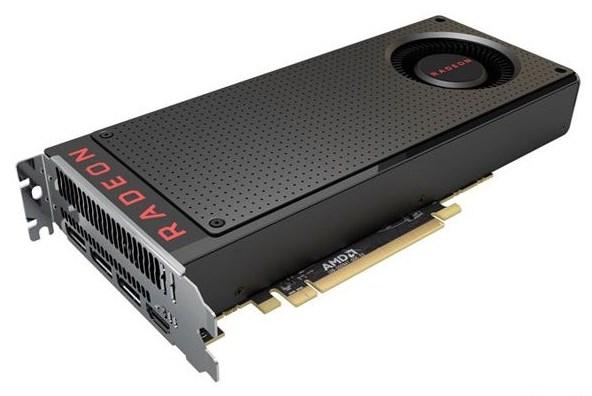
Image source: AMD
Investor takeaway
Will the RX 480 be a hot seller? If AMD can keep a lid on the power draw situation it likely will, at least until the GeForce GTX 1060 arrives. What is really at issue here is that this design once again shows the dire straits AMD is in.
AMD shared earlier this month that the RX 460, 470 and 480 comprise the full Polaris lineup so the company has nothing up its sleeve to fight the GeForce GTX 1060. If the latter performs good, the only weapon AMD has left is a reduction of its profit margins on the Polaris lineup.
In the short-term, the situation is good for gamers due to the low pricing of the card and the downward pressure on NVIDIA's GeForce cards. But from an investor-perspective, AMD's lack of innovation and continued absence of pricing power doesn't bode well.
This article was written by

An early 30-something investor from Belgium with a focus on building a dividend growth-oriented portfolio to achieve financial independence within the next two decades. I write primarily about US and European dividend stocks.
Disclosure: I/we have no positions in any stocks mentioned, and no plans to initiate any positions within the next 72 hours. I wrote this article myself, and it expresses my own opinions. I am not receiving compensation for it (other than from Seeking Alpha). I have no business relationship with any company whose stock is mentioned in this article.
Source: https://seekingalpha.com/article/3985569-amd-radeon-rx-480-good-bad-and-ugly-power-draw
0 Response to "Rx 480 Make Fans Continuously Blow"
Post a Comment